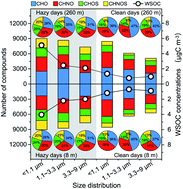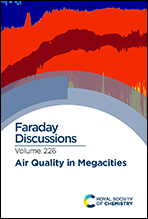Molecular characterization of size-segregated organic aerosols in the urban boundary layer in wintertime Beijing by FT-ICR MS†
Abstract
Organic aerosols, complicated mixtures of organic compounds, are important constituents of atmospheric particulate matter. However, little is known about the size distributions and vertical profiles of these constituents at a molecular level in the urban boundary layer. Here, we characterized the molecular compositions of size-segregated samples collected simultaneously at two heights (8 m and 260 m above ground level) in urban Beijing during the winter of 2018. The CHO, CHNO, CHOS, and CHNOS subgroups in water-soluble organic carbon were characterized using a 15-T ultrahigh-resolution Fourier transform-ion cyclotron resonance (FT-ICR) mass spectrometer. We found that both their numbers and magnitudes increased with a decrease in the particle size, especially for high molecular weight (HMW) compounds, except CHNOS. The number of CHNOS species also increased in the coarse mode, presumably because the alkalinity could inhibit their hydrolysis in the coarse mode. The compounds in small particles with higher O/C ratios and carbon oxidation state were possibly more aged, while the coarse particles with more lipid- and peptide-like compounds should originate from fresh emissions. Moreover, as the oxidation state increases in small particles, functionalization is enhanced for sulfur-containing compounds with fracturing of the benzene ring, while CHO and CHNO are potentially dominated by demethylation with ring-retaining products. It is worth noting that common compounds with the same molecular characteristics accounted for more than 86% of the total compounds between 260 m and ground level (8 m), demonstrating that the aerosols were well mixed in the urban boundary layer. Nonetheless, the relative content of the compounds was higher at ground level due to the impact of primary emissions, which increased with the particle size. In addition, the compounds in submicron particles were more oxidized at 260 m, while the opposite was observed in the coarse mode.

- This article is part of the themed collection: Air quality in megacities


 Please wait while we load your content...
Please wait while we load your content...